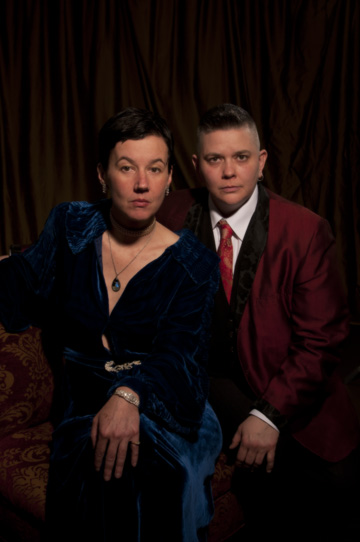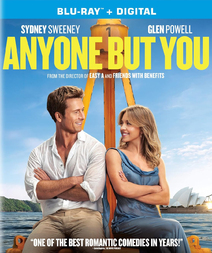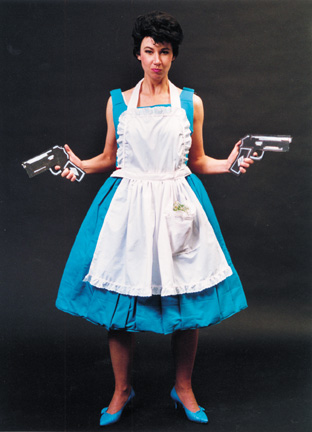

Interview: A conversation with performance artists Shawna Dempsey and Lorri Millan
Filed under: Interviews
Feminist art fans take note. A vault is about to open, filled with the most subversively unique and beautifully hilarious gems. For the first time, a curated collection of the work of performance artists Shawna Dempsey and Lorri Millan will be available on Sept. 26. as part of the WNDX Festival of Moving Image's 10th anniversary.
Dempsey and Millan's work has been seen all over the world, including the Museum of Modern Art in New York City. The pair have collaborated on dozens of films, videos and performance art pieces over the last 25 years, in countless genres and styles. Super is a playful twist on the ever-popular superhero genre. Good Citizen Betty Baker is a satiric parody of 1960's serialized storytelling (and antiquated gender roles.) Calamity is a haunting and thoughtfully evocative meditation on the life and psyche of Calamity Jane and her timeless, transcendent role in the fabled Old West.
Executing each piece with a remarkably cinematic edge and a saturated, pop culture chic, Dempsey and Millan thematically identify their work as "explicitly feminist." Skewering taboo subjects with blistering irreverence and masterful command of tone, each piece is uniquely different and yet, tonally analogous to their overall body of work. As Dempsey and Millan attest, they are two artists who share one voice. Their message is infused with a wry, comical delivery, which ensures that their goal is to entertain, as well as inspire.
The DVD release takes place Sept. 26 from 7 - 8:30 pm at Winnipeg Cinematheque and is free to attend. The release party will accompany a screening of the selected works, which in addition to Good Citizen Betty Baker, Calamity and Super, will include Vigilance, A Day in the life of a Bull-Dyke, Homogeneity, We're Talking Vulva, Archaeology and You, and Lesbian National Parks and Services: A Force of Nature.
Tony Hinds: How did you originally get into performance art?
Shawna Dempsey: I was at (York University) and I learned about performance art and I immediately started doing performance art because I thought, "Oh I could do that." And then, (Lorri and I) met and became friends. (Lorri) had been making films, but we were both working in theater as technicians. So we were around performance forms all the time. And I was doing my own performance work, and then (Lorri) started helping me with it. And then we became a couple. We split up later, but anyway.

Lorri Millan: The long and the short of it is that it was a period of time when lots of people were using performance.
SD: Other feminist artists.
LM: But we started very quickly making films and videos. We actually don't ever call ourselves filmmakers.
SD: That's true. We started working together, officially, in 1989. We met in '86 but we officially started our collaboration...
LM: *Laughs* We finally acknowledged this thing that was going on.
SD: *Laughs* And then, we made our first film in '90.
LM: And really, we've made many more videos than films. Not that that's a very important distinction anymore, but it used to be more important. It's a different milieu and a more multi-disciplined platform. But we still do both. We still make and develop public art projects. We do all sorts of different things.
SD: We've written books.
LM: The books. Yeah, we kind of let the idea drive the form, if that makes sense.
TH: Sure, definitely.
SD: Most recently, we curated a screening of experimental feminist shorts that use the horror genre, and we screened it at a drive-in in rural Ontario. The form drives how the whole thing happens.
LM: Or the idea drives the form. The form drives the presentation? I don't know. There's something in there.
SD: *Laughs*
TH: I know what you mean though. It's better for an artist to have an idea for... for example, a film, and then realize, "Oh it's a film in whichever genre." As opposed to sitting down and saying: "I want to make a film in whichever genre..." and then, start trying to reverse engineer an idea.
SD: That's right.
TH: So how did your involvement in the WNDX Festival, and your upcoming DVD release come about?
LM: They asked us. *Laughs* That's it really. Shawna had a long exchange with Solomon Naglar who was one of the people behind (the festival.) They just called us up and said: "We have this idea." And we said: "Cool." The timing was really good for us because we had spent most of the winter remastering our films and videos. Taking the tapes and digitally remastering them. So it all came together very nicely. This will be a great showcase for the remastered work.
TH: Yeah, it's cool for an art and movie geek like myself to discover this treasure trove of amazing work. And there's so much of it! For me, it was a huge revelation.
LM: Well, we're in an age where the idea of making our work available for free has been an ongoing debate. I mean, off and on, we make a tiny, small sum from distributing our work, and it's purchased for libraries and things like that. So until recently we've been hold outs about making too much available. Plus we've had website problems in the past, having things available on our site and going beyond our bandwidth. We're just old school in that we feel we should be paid for our work.
TH: Absolutely.
LM: But I think things have changed so much now. We were concerned that for some people, we didn't exist. Or didn't exist in a way that's meaningful because so many artists works are available. We just reached that point where we realized it's counterproductive.
TH: That's a common concern for many artists... finding a middle ground between giving everything away for free and having zero brand awareness, for lack of a better term.
LM: It's also a respect issue. Our issue is respecting the actual object, in this case it's film or video. Will people want to show these low-res representations in a classroom? You know, instead of doing the right thing, renting or buying it?
TH: Sure, but what I saw was so great! Each piece was so unique and different. Each employed a different style, and yet, they all still shared an individual voice.
LM: *Laughs* I know what you mean. One brain, two bodies.
TH: On the DVD, Good Citizen Betty Baker is one of my favorites. That could be a television show and I would watch it every week! Watching it, I just felt like, "Of course..." It feels familiar and yet, unfamiliar at the same time.
SD: *Laughs* I totally know what you're saying. A lot of our work does feel familiar because we use nostalgia or we use familiar forms as an access point, and then, once we've got you, we deliver our own content.
LM: Soften ya up and then, give ya the one-two!
TH: How did the Betty Baker piece come about?
SD: I think we were interested in the form, the cliffhanging mystery...
LM: The serialized mystery that we would see week to week in a theater, or as we all grew up with serialized television from the 50's and 60's.
SD: And in the 90's, we were really interested in putting lesbian content into mainstream forms. There's another piece that is not on the DVD, called What Does A Lesbian Look Like? that was on Much Music. To get all those lesbians into children's homes between Metallica and Madonna was just fantastic! When we were making Good Citizen Betty Baker, we didn't see ourselves represented in the mainstream at all. So it was really about putting ourselves into culture. Seeing ourselves in the culture, because we weren't.
LM: There's the ongoing stuff about conformity and that was the irony of the piece, was that we play with this very conformist world. It's interesting that you bring up What Does A Lesbian Look Like? because I watched it as they remastered it and I thought, "Oh, this is dated feeling." It's one of our pieces that I wasn't sure how it would translate.
SD: Or holdup.
LM: Whereas Betty Baker... this is where the power of a story and humor really comes through. I was refreshed and surprised by how much I liked it when we were remastering it. But I think we're very much products of our 60's and 70's childhoods, so I think that aesthetic... as Shawna said, you take this familiar form and you create some tension, some humor by having this whole other set of contents and ideas that you can talk about.
TH: I also watched Transport (a beautifully eerie staged-piece, in which the in-person audience is placed in the seats of an actual airplane) on your Vimeo Channel, which is great. I didn't know... because I had watched some of the other pieces earlier... I take it was performed as a live piece?
SD: Yeah, it was done live.
LM: We have work that we create for film and video, and we have all this other live work that we don't tend to... that was another reluctance to have it all available together on one site. A document (of a live performance) is very different than a piece that has been conceived for film or video, which tend to be much more successful. There's some pieces that due to limitations, such as they need to take place on an airplane or in an elevator that might not be seen as widely otherwise. And actually, that document (of Transport) turned out okay. But obviously it's not the same as the ones that were conceived to be videos.
TH: There's a great subversive quality to the comedy, as well. You walk that fine line beautifully. I also watched What Does A Lesbian Look Like? again. This morning actually. It's funny you said dated, because it does feel very much of that moment. When you say dated, maybe I agree, but not necessarily in a bad sense. It's a snapshot of a place in Canadian pop culture. Even those little images of the Much Music...
SD: The tags!
TH: Yes, the interstitial Much Music tags at the opening of the video. It all sweeps together and made me feel like... "Here I am. I'm 12 years old again and sitting in front of my parent's TV, watching Much Music." I was thinking to myself, I probably saw this when I was a kid. It was certainly not dated in a bad way.
SD: It's funny. Another artist also suggested to us that we were placing queer content into the artifacts of our childhoods. Because we didn't grow up seeing lesbians represented like this.
LM: Somebody smarter than us said that.
TH: *Laughs*
LM: And we're working our way through all various eras. Even beyond our childhood in some of the forms that we've played with.
For more information on Shawna Dempsey and Lorri Millan, check out their website, shawnadempseyandlorrimillan.net. And check our their work online on Vimeo.
This interview has been edited/ condensed for length.
All photos provided. (Pictured: Shawna Dempsey and Lorri Millan, L - R)
Tags: Shawna Dempsey, Lorri Millan, Good Citizen Betty Baker , WNDX Festival of Moving Image, interview, interviews
Related Posts
- Newfoundland folk duo Fortunate Ones visit the Winnipeg Folk Festival fresh off releasing new full-length, Hold Fast
- The Supporting Act Podcast Ep. #043 with Fred Penner
- The Supporting Act Podcast Ep. #042 with Stephen Sim
- The Supporting Act Podcast Ep. #038 with Graham Clark
- A Walkthrough of New Image College and New Image Entertainment
Tony Hinds is a Canadian writer who studied film at the University of Winnipeg. In addition to ShowbizMonkeys.com, Tony has reviewed films for Step On Magazine and The Uniter. You can find Tony on Twitter.







Comments Posted (